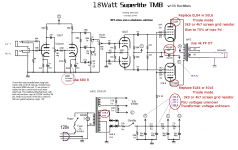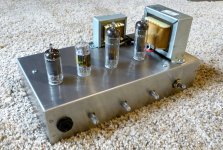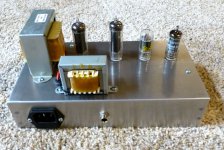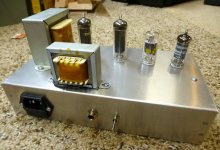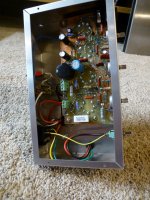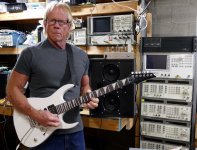You have an excellent visual memory....it took me about 8 milliseconds to figure out where those triode curves came from...
I wasn't trying to keep any secrets - I just didn't notice that the name of the device had been lost while cropping the data sheet to zoom in on the nonlinearity.
For anyone who's interested, those triode curves are from the triode half of a 6JW8 triode-pentode TV tube.
I got a voltage gain of 50x (or 34 dB) out of this triode without any trouble, not much less than the 60 - 65x one can typically get out of a half-12AX7. Even though mu is lower at 70, so is ra (rp), so loading effects are reduced, and you end up with an actual voltage gain closer to mu than you can usually get with a half-12AX7 (unless you buffer its output, etc.)
-Gnobuddy
You have an excellent visual memory.
Not really. I have a box full of those as well and remembered the number from one of your previous posts.
Lovely for both  Nice for low voltage MI use, especially if you like to get your distortion in the earlier stages of the amplifier. give it a high value screen resistor when you triode strap it (several K-ohms at least) and some series resistance in the power supply for some compression. I built a marshall 18W TMB "lite" using triode connected 50L6 outputs this way a couple years back, and it's working out beautifully for the owner as a practice amplifier, and for small church worship team guitar use. Smooth and rips into some beautiful soft distortion when pushed with aggressive picking.
Nice for low voltage MI use, especially if you like to get your distortion in the earlier stages of the amplifier. give it a high value screen resistor when you triode strap it (several K-ohms at least) and some series resistance in the power supply for some compression. I built a marshall 18W TMB "lite" using triode connected 50L6 outputs this way a couple years back, and it's working out beautifully for the owner as a practice amplifier, and for small church worship team guitar use. Smooth and rips into some beautiful soft distortion when pushed with aggressive picking.
Sounds great! Can we talk you into sharing any more info? Or do you perhaps have an existing thread you can point us at?I built a marshall 18W TMB "lite" using triode connected 50L6 outputs this way a couple years back, and it's working out beautifully <snip>
I love guitar amp designs using cheap, unloved radio and TV tubes, which so often turn out to be fantastic choices for low-powered guitar amps. Amps we can actually use without upsetting the neighbours. Or the cat.
-Gnobuddy
No thread, and other than the output tubes, it's basically this circuit, triode connected 50L6's, with a 4K no-name output transformer, biased to ~70% max dissipation and I forget the cathode resistor value. I think 3300R or 4700R screen resistors? I used the smaller "more crunch" cathode resistor on the second triode.d

I can't play guitar to save my life, but I'm told it has a very easy to push tone, very responsive to playing style. Satisfying c r o n c h when you get aggressive.

I can't play guitar to save my life, but I'm told it has a very easy to push tone, very responsive to playing style. Satisfying c r o n c h when you get aggressive.
Thanks for those details! Is the attached image about right?
- this circuit
- triode connected 50L6's
- 4K no-name output transformer
- biased to ~70% max dissipation
- cathode resistor value?
- 3300R or 4700R screen resistors
- smaller "more crunch" cathode resistor on the second triode
IMO "your life" is just about what it takes...ten years to get halfway decent, and another ten to start to learn the thousands of minute details that advance you another few percent, and so on.I can't play guitar to save my life
The lucky ones start out when they're five years old, so they're already really good at 25. Those of us who started as adults just keep working at it until arthritis and old age finally put an end to our aspirations. But you also get years and years of enjoyment along the way, and friendships you might never have made without music.
-Gnobuddy
Attachments
Translation: Just to be on the safe side, don't touch either of the speaker leads when the amp is powered on. Try to arrange things so it is impossible to touch the speaker leads when the amp is powered on, just in case the audio line transformer insulation "flashes over" and the B+ voltage gets through to the speaker side.
I zapped myself once and learned my lesson, was holding a chassis on my lap and put my finger where I shouldn't. I developped such of a paranoia and will not use my 2 hands to work in a chassis anymore, this will never happen again.
As playing with high voltages I'm doing the most as I can to work with tools like this so I don't have to use my little fingers, also did myself a nice amp cradle, even I sticked some warning in my shop saying in BIG BOLD characters -> BEWARE !!!! DISCHARGE CAPACITORS
Safety FIRST
OTOH, there are reports of sucessful usage of transformers of that kind in PP amplifiers that operate at higher plate voltages!
Best regards!
Thank you very much I didn't know about a successful story with these, just remember having seen this on a radio forum.
I did some more tests and really love the sound, I'm gonna stick with it.
An un-gapped E-I core will "work" in an SE amp, if it is about 4X the size of an optimum gapped core. On a flat earth, this is dumb economics. On our earth, today, "big" 70V trannies are much cheaper than small SE trannies, so not a dumb idea.
The common 70V trannies are usually poor bass. Actually they do OK when fed from a large power amplifier. When fed from a tube they may be bass-shy. Up-sizing another 2X may help a bunch.
Yeah, a "10W" core may be fine for ~~1W 50L6 in guitar-amp duty.
Thanks for this confirmation, Gnobuddy has scared me with the insulation
Maybe it can be compensated with a good matching speaker, for now I'm doing my tests on a WGS G8C, but it sounds gud once broken up, for a little 8".
Thank you for dropping the good advice, short but always right to the point, I'm reading all of them carefully!
Because of the price of transformers "down under" so far these are the only trafos I have used - both for SE and for PP. But I only make little amps in the range of .15 to 15 watts.
Oh yes, not to say all the other parts in the industry 'known to be popular', money money!!
Thanks for sharing this!
A triode output will probably give more bass with the 70 V transformer due to it's lower output impedance.
Oh, my little Blackheart has a switch for pentode/triode mode and really love that!
I never thought about doing that with the 50L6, thank you
The 50L6 is a 6W6 with a 50 volt heater. I have been experimenting with the 6W6 types for HiFi use and they are indeed quite clean in triode mode. Want to dirty them up a bit, just raise the value of the screen stopper resistor.
Oh yes I love dirty amps!!
There's no screen resistor in the schematic, so if I put a resistor there, gonna have more grit, right?
Thanks for sharing this, makes me want that 50L6 amp with a switchable triode mode, more than ever!
Lovely for bothNice for low voltage MI use, especially if you like to get your distortion in the earlier stages of the amplifier. give it a high value screen resistor when you triode strap it (several K-ohms at least) and some series resistance in the power supply for some compression. I built a marshall 18W TMB "lite" using triode connected 50L6 outputs this way a couple years back, and it's working out beautifully for the owner as a practice amplifier, and for small church worship team guitar use. Smooth and rips into some beautiful soft distortion when pushed with aggressive picking.
Not really sure about how to hook the screen to the plate, with a resistor or not..
Thanks a lot for sharing your experience with this tube, as well as for the Superlite schematic, I was looking for a schematic 'exactly' like that, right in the list for a next built!
I'm doing millions things at once right now, life's keeping me a little busy but I'm reading all of you, and also a lot from here and there, you guys help me a lot to stay focused on the important things!
This amp will be great!
I love guitar amp designs using cheap, unloved radio and TV tubes, which so often turn out to be fantastic choices for low-powered guitar amps. Amps we can actually use without upsetting the neighbours. Or the cat.
-Gnobuddy

I'm very glad to hear you take safety seriously. Good for you!...will not use my 2 hands to work in a chassis anymore...

When I started to get interested in valve circuits around 2009 - 2010, I tried to make sure I got the safety information first.
One of the things I kept reading was "Use only one hand, keep the other in your pocket". And I thought to myself, that sounds like advice from 1930, surely there is something better than that? You can still get shocked - maybe killed, electrocuted - if you touch the wrong thing with only one hand. What options are there in the 21st century? What do all those millions of electricians do to stay alive and safe?
Safety always requires many different elements, but it turns out that a key element is modern electricians gloves: Insulated Rubber Gloves, Class 00, 0, 1, 2, 3 & 4 - 500v, 1000v, 7.5kv, 17kv, 26.5kv, 36kv
For typical tube amps, class 00 gloves will probably do:Electrical Gloves - Acklands-Grainger, Canada
Gloves can puncture, crack from age, et cetera, so electricians go through regular glove testing: 5 Things You Should Know about Electrical Gloves - Grainger Safety Record
Regular glove safety testing may not be practical for us home DIY builders, but wearing a pair of class 00 or class 0 gloves when working on a live chassis is still a definite improvement over wearing no protective gear at all.
Another thing I've considered seriously is getting a leather or rubber (or even thick cloth) apron and wearing that when working on valve circuitry. I have read too many stories about a live chassis falling into someone's lap, or maybe not the entire chassis, just the bare end of a live wire.
-Gnobuddy
When I started tinkering with electronics and making guitar amps, radios often had one side of the power line DIRECTLY connected to the chassis. When the dumb blonde kid wires his guitar into one of these and gets blown across the room by touching it he learns quickly NOT to do that again.
My first DIY guitar amp was made from an old Magnavox console which had a suitable power transformer and was relatively safe, and I used it for a couple of years. It's the stuff that came later that was dangerous and stupid. Fortunately, I made it to old age and can explain how "NOT to do that again."
First off the 50L6 and its relatives were used in "hot chassis" radios where raw line voltage was used to heat the tubes, and provide B+ voltage. People were KILLED by these radios and the shocking guitar amps that were sold by the thousands in the 50's and 60's. If you run across one of these old amps that does not have a power transformer DO NOT USE IT until a proper isolation transformer and 3 wire power cord has been installed by someone who understands why this is necessary.
If a heater to cathode short occurs (not uncommon), or the "death cap" fails (again, not uncommon) it's the same thing electrically as plugging your guitar cord into the wall outlet. If bad stuff happens especially if you are hot and sweaty, you will not be able to let go of an electrified guitar when you are standing barefoot on concrete. It's one of those experiences you remember forever.......if you survive.
It's easy to power a pair of 50L6's or 50C5's and one or two 12AX7's by wiring all of the heaters in series and running them from the 120 volt line. This is how they were intended to be used. Today we should power the entire amp from an isolation transformer like the Triad N-68X. Think of it as a $16 life insurance policy. If you prefer the old school approach, use 12L6's or 12W6's (same tube) and wire all the heaters in parallel from a 12 volt winding like both 6 volt windings on am Antek toroid in series. You can also use 6W6's and go the conventional 6.3 volt transformer route......do I like these tubes? Well I have a box of 100 6DG6's (again, the same tube) on the way. Once they get here we will see how to squeeze nearly 40 watts from a pair.
So there are several ways to power the 6W6/6DG6, 12L6/12W6, 25L6/25W6 and 50L6 tubes. Note that these are not the same as the 6L6 or 35L6 which themselves are not related.
What do we use for the OPT? The 70 volt line transformers have been suggested. Will they work, and how much power can we squeeze through one?
Somewhere in another thread I had cranked 30+ watts out of a pair of 50B5's or 32ET5's using a bench power supply and a real 3300 ohm OPT. I then substituted this $5 70 volt line transformer:
70V 10W Speaker Line Matching Transformer
I cranked up the voltage and power level to see if the little "OPT" would fry. Saturation at guitar frequencies (70 Hz and up) starts to show at 10 watts. The transformer I used survived at 340 volts of B+ which puts nearly 700 volts on the primary winding. This was one test on one transformer, and there is no guarantee that the next one will eat this much voltage.
If I were to try this in an amp that I will use (I just might) I would make sure that the amp chassis was properly grounded via the green wire of the line cord, and a suitable line fuse is used. Make sure that one side of the OPT secondary (black wire) was connected to this ground. That way the fuse, or something else inside the amp will blow if the transformer ever develops a primary to secondary short. A blown fuse, power transformer, or rectifier is better than 340 volts on your speaker wires!
I built an amp using this transformer for an OPT. It makes about 3 watts from a 170 volt supply with 32ET5 tubes. It has been the only working guitar amp that I have except for a 100 watt monster that's far too loud to crank. I have played it off and on for almost 4 years without issue. Maybe someday I'll make a proper box for it.
My first DIY guitar amp was made from an old Magnavox console which had a suitable power transformer and was relatively safe, and I used it for a couple of years. It's the stuff that came later that was dangerous and stupid. Fortunately, I made it to old age and can explain how "NOT to do that again."
First off the 50L6 and its relatives were used in "hot chassis" radios where raw line voltage was used to heat the tubes, and provide B+ voltage. People were KILLED by these radios and the shocking guitar amps that were sold by the thousands in the 50's and 60's. If you run across one of these old amps that does not have a power transformer DO NOT USE IT until a proper isolation transformer and 3 wire power cord has been installed by someone who understands why this is necessary.
If a heater to cathode short occurs (not uncommon), or the "death cap" fails (again, not uncommon) it's the same thing electrically as plugging your guitar cord into the wall outlet. If bad stuff happens especially if you are hot and sweaty, you will not be able to let go of an electrified guitar when you are standing barefoot on concrete. It's one of those experiences you remember forever.......if you survive.
It's easy to power a pair of 50L6's or 50C5's and one or two 12AX7's by wiring all of the heaters in series and running them from the 120 volt line. This is how they were intended to be used. Today we should power the entire amp from an isolation transformer like the Triad N-68X. Think of it as a $16 life insurance policy. If you prefer the old school approach, use 12L6's or 12W6's (same tube) and wire all the heaters in parallel from a 12 volt winding like both 6 volt windings on am Antek toroid in series. You can also use 6W6's and go the conventional 6.3 volt transformer route......do I like these tubes? Well I have a box of 100 6DG6's (again, the same tube) on the way. Once they get here we will see how to squeeze nearly 40 watts from a pair.
So there are several ways to power the 6W6/6DG6, 12L6/12W6, 25L6/25W6 and 50L6 tubes. Note that these are not the same as the 6L6 or 35L6 which themselves are not related.
What do we use for the OPT? The 70 volt line transformers have been suggested. Will they work, and how much power can we squeeze through one?
There is one other concern to keep in mind with these little 70V transformers - we don't know how good the insulation between primary and secondary windings is.
Somewhere in another thread I had cranked 30+ watts out of a pair of 50B5's or 32ET5's using a bench power supply and a real 3300 ohm OPT. I then substituted this $5 70 volt line transformer:
70V 10W Speaker Line Matching Transformer
I cranked up the voltage and power level to see if the little "OPT" would fry. Saturation at guitar frequencies (70 Hz and up) starts to show at 10 watts. The transformer I used survived at 340 volts of B+ which puts nearly 700 volts on the primary winding. This was one test on one transformer, and there is no guarantee that the next one will eat this much voltage.
If I were to try this in an amp that I will use (I just might) I would make sure that the amp chassis was properly grounded via the green wire of the line cord, and a suitable line fuse is used. Make sure that one side of the OPT secondary (black wire) was connected to this ground. That way the fuse, or something else inside the amp will blow if the transformer ever develops a primary to secondary short. A blown fuse, power transformer, or rectifier is better than 340 volts on your speaker wires!
I built an amp using this transformer for an OPT. It makes about 3 watts from a 170 volt supply with 32ET5 tubes. It has been the only working guitar amp that I have except for a 100 watt monster that's far too loud to crank. I have played it off and on for almost 4 years without issue. Maybe someday I'll make a proper box for it.
Attachments
What plate voltage were you running?
I was using a no-name 100VA, dual 115V secondary toroid for power, with a single winding for the heaters (all strung in series, with the 50L6 filaments on either side of the 12AX7s, and then grounding the center tap of the 12AX7 filaments with them wired 4/5 and pin 9 for 6 volts, sorry if it sounds complicated, as it's not really) and a full wave voltage doubler for around 300V raw supply voltage with the amp idling. The doubler sagged a bit under high power, and was a nice way to go for a cheap build, with similar results to the sag from a tube rectifier.
Sorry that I don't have more details, as it was practically a sweep-the-floor build with parts-box grade parts, and a chassis from inside an old record player. None of the specifics are all that critical
...."Use only one hand, keep the other in your pocket". And I thought to myself, that sounds like advice from 1930, surely there is something better than that? You can still get shocked - maybe killed, electrocuted - if you touch the wrong thing with only one hand....
At voltages normally found in houses--- no, you are not likely to die or even be seriously shocked from *exactly* ONE point of contact.
The classic TWO-contact path is hand to hand, through the heart.
The sneaky TWO-contact path is hand to foot, through the heart.
But electricity bites many ways. I do have long-term damage from "one hand shock". 600V to tip of little finger then out through wrist resting on chassis. Obviously with higher V and A it could be possible to burn-off that finger and still live fine. In this case it looked fine, but was numb, and is still semi-numb decades later.
Yesterday I touched 450V by left hand when holding the chassis by the right hand. Through the heart? I did not feel that, but I felt it going through the mouth, because of sour taste. 
50L6 are tubes of my choice (I have a stash of 12L6). They are great for hifi amps. Very clean tubes. But I worry about filaments of 12AX7 in an amp for guitar pickup sensitivity with overdrive. I did not try that, but I am afraid of hum.
50L6 are tubes of my choice (I have a stash of 12L6). They are great for hifi amps. Very clean tubes. But I worry about filaments of 12AX7 in an amp for guitar pickup sensitivity with overdrive. I did not try that, but I am afraid of hum.
I had the same experience first time at the age of 15. Did not like it that much. It was the last as well - since them I build with "sand".Yesterday I touched 450V by left hand when holding the chassis by the right hand. Through the heart? I did not feel that, but I felt it going through the mouth, because of sour taste.
This is is the one that was in the back of my mind. I experienced one like that in my teens, standing barefoot on a concrete floor. In a few painful seconds, I learned three rather unpleasant things:The sneaky TWO-contact path is hand to foot, through the heart.
- The enamel wire insulation in the electromagnet I'd just wound had failed and there was a short to the iron core, which I was holding in my hand.
- Concrete floors conduct electricity. Surprise!
- 240V AC running through your hand will hurt, contract your muscles, and confuse your mind enough to require making a conscious effort to let go.
The class 00 gloves are thick and awkward, but I try to discipline myself to wear them whenever doing something potentially dangerous with a live (tube) circuit.
-Gnobuddy
Some wasteful but highly effective brute-force hum reduction could be to run the heater string off of DC from a simple zener-referenced mosfet follower type of filter. You'll need a yuuuuge heatsink, but those can be found and/or repurposed easily. Nothing like a pant-load of standing current to keep the mosfet in a happy place. Run enough tubes in series and you'll reduce waste heat too 
Could be a useful way to go for someone with more tubes than they do transformers and/or sense
Could be a useful way to go for someone with more tubes than they do transformers and/or sense

And I've cut and pasted all your information from that thread to a document saved on my computer. Someday I will follow your trail with a pair of 12C5s or 25C5s, just because of the sheer ridiculousness of squeezing 30 watts out of a pair of unloved $1 valves designed to spit out only a couple of watts.Somewhere in another thread I had cranked 30+ watts out of a pair of 50B5's or 32ET5's using a bench power supply and a real 3300 ohm OPT.
My current build has convinced me that a quarter-watt guitar amp feeding a proper guitar speaker is already too loud to overdrive in my apartment. So I'm not sure the 30-watter will ever be used to it's capacity. Still, the ludicrousness factor is so big that I almost have to build it!
-Gnobuddy
- Status
- This old topic is closed. If you want to reopen this topic, contact a moderator using the "Report Post" button.
- Home
- Live Sound
- Instruments and Amps
- 50L6 guitar amp
